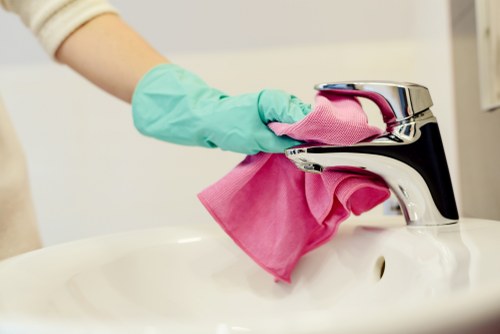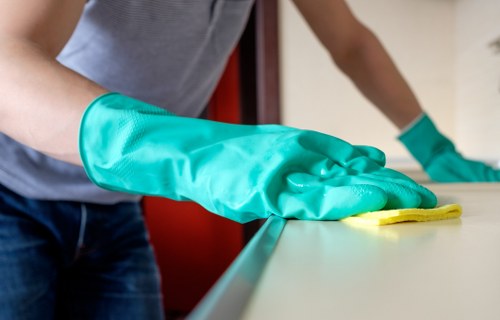Hard Floor Cleaning in Spot Cleaners: Achieve Spotless Floors with Ease

Hard floor cleaning is essential for maintaining the beauty and longevity of your flooring. Whether you have hardwood, tile, laminate, or vinyl floors, keeping them clean not only enhances their appearance but also preserves their integrity. One of the most effective tools for this task is a spot cleaner designed specifically for hard floors.
Spot cleaners are versatile machines that target specific areas, making them perfect for tackling stubborn stains, spills, and high-traffic zones. Unlike traditional mops or brooms, spot cleaners offer a more thorough and efficient cleaning process, ensuring that every corner of your floor is spotless.
In this comprehensive guide, we'll explore the benefits of using spot cleaners for hard floor cleaning, provide tips on choosing the right model, and offer step-by-step instructions to help you achieve the best results.

The Importance of Hard Floor Cleaning
Maintaining clean hard floors is crucial for several reasons. Firstly, regular cleaning prevents the buildup of dirt, dust, and debris that can scratch and damage your flooring over time. Secondly, clean floors contribute to a healthier living environment by reducing allergens and bacteria that can cause respiratory issues.
Moreover, well-maintained hard floors enhance the overall aesthetic of your home, making spaces look more inviting and well-kept. Whether you're preparing for guests or simply enjoying your daily routine, clean floors can significantly impact the comfort and appeal of your living space.
Investing in a quality spot cleaner for hard floors ensures that you can maintain this level of cleanliness with minimal effort, saving you time and money in the long run.

Benefits of Using Spot Cleaners for Hard Floors
Spot cleaners offer numerous advantages over traditional cleaning methods. Here are some key benefits:
- Efficiency: Spot cleaners are designed to clean large areas quickly, making them ideal for busy households.
- Deep Cleaning: They penetrate deeper into the flooring, removing embedded dirt and stains that regular mopping might miss.
- Ease of Use: Modern spot cleaners are user-friendly, with features like adjustable settings and ergonomic designs.
- Versatility: Many spot cleaners come with multiple attachments, allowing you to clean various surfaces and hard-to-reach areas.
- Improved Hygiene: By effectively removing allergens and bacteria, spot cleaners contribute to a healthier home environment.
These benefits make spot cleaners an invaluable tool for anyone serious about maintaining clean and beautiful hard floors.

Types of Hard Floors Compatible with Spot Cleaners
Spot cleaners are compatible with a wide range of hard floor types. Understanding which floors can be effectively cleaned with a spot cleaner ensures you choose the right tool for your needs.
Hardwood Floors
Hardwood floors are a popular choice for their timeless beauty and durability. Spot cleaners can safely clean hardwood floors without causing damage when used correctly. It's essential to use gentle cleaning solutions and avoid excessive water to protect the wood from moisture-related issues.
Tile Floors
Tile floors, including ceramic and porcelain, are highly compatible with spot cleaners. These floors are resistant to moisture and staining, making them ideal candidates for deep cleaning. Spot cleaners can effectively remove grout stains and buildup, restoring the tile's original appearance.
Laminate Floors
Laminate floors mimic the look of hardwood but require specific cleaning methods to prevent damage. Spot cleaners designed for laminate floors use low-moisture cleaning solutions that effectively remove dirt and stains without warping or damaging the surface.

How Spot Cleaners Work on Hard Floors
Understanding how spot cleaners operate can help you maximize their effectiveness. Spot cleaners typically use a combination of suction and cleaning solutions to remove dirt and stains from hard floors.
When you use a spot cleaner, you apply the cleaning solution to the desired area. The machine then agitates the solution to loosen dirt and grime before suction removes the dirty water, leaving your floor clean and dry.
Many spot cleaners also feature adjustable settings that allow you to control the intensity of the cleaning process, ensuring that your hard floors are cleaned thoroughly without any damage.

Key Components of a Spot Cleaner
Spot cleaners consist of several essential components that work together to deliver effective cleaning:
- Cleaning Solution Dispenser: Releases the appropriate amount of cleaning solution onto the floor.
- Brush Roll: Agitates the cleaning solution, helping to lift dirt and stains.
- Suction System: Extracts dirty water and cleaning solution from the floor, preventing residue buildup.
- Filters: Trap fine particles and prevent them from being released back into the air.
- Adjustable Settings: Allow you to customize the cleaning process based on your floor type and cleaning needs.

Step-by-Step Guide to Cleaning Hard Floors with a Spot Cleaner
Cleaning your hard floors with a spot cleaner is straightforward when you follow the right steps. Here's a detailed guide to help you achieve the best results:
Preparation Before Cleaning
Before you begin, prepare your space to ensure an efficient cleaning process. Start by removing any furniture and objects from the area you intend to clean. This step prevents obstacles and allows the spot cleaner to access all parts of the floor.
Next, sweep or vacuum the floor to eliminate loose dirt and debris. This initial step ensures that the spot cleaner can focus on tackling tougher stains and embedded dirt.
Finally, inspect the floor for any specific stains or areas that require special attention. Knowing where to concentrate your efforts will save time and improve the overall effectiveness of the cleaning process.

The Cleaning Process
With your space prepared, it's time to use the spot cleaner. Start by filling the machine's water tank with the recommended amount of water and adding the appropriate cleaning solution. Refer to the manufacturer's instructions to ensure you're using the correct mixture for your specific floor type.
Turn on the spot cleaner and begin cleaning by moving the machine slowly over the stained or dirty areas. Allow the spot cleaner to do the work, avoiding swift movements that might reduce cleaning effectiveness.
Pay attention to high-traffic areas and stubborn stains, making multiple passes if necessary to achieve a thorough clean.
Post-Cleaning Maintenance
After completing the cleaning process, it's essential to maintain your spot cleaner to ensure its longevity and performance. Start by emptying any remaining dirty water from the machine's tank to prevent mold and bacteria growth.
Next, clean the brush rolls and filters to remove any residual dirt and debris. This step ensures that the spot cleaner remains efficient for future use.
Finally, store your spot cleaner in a dry, safe place, ready for your next cleaning session.

Choosing the Right Spot Cleaner for Your Hard Floors
Selecting the appropriate spot cleaner is crucial for achieving optimal cleaning results on your hard floors. Consider the following factors to make an informed decision:
Features to Consider
- Adjustable Settings: Look for spot cleaners with adjustable suction and cleaning modes to customize the cleaning process based on your floor type and cleaning needs.
- Attachment Variety: A good spot cleaner should come with various attachments, such as corner brushes and crevice tools, to reach every part of your floor effectively.
- Capacity: Ensure the water tank is sufficiently large to cover the areas you plan to clean without frequent refills.
- Weight and Maneuverability: Choose a lightweight and easy-to-maneuver spot cleaner to reduce fatigue during extended cleaning sessions.
- Filtration System: High-quality filters trap fine particles, improving air quality and preventing dirt from being recirculated into the room.

Top Spot Cleaners in the Market
There are numerous spot cleaners available, each with unique features catering to different cleaning needs. Here are some top-rated models:
- Bissell SpotClean Pro: Known for its powerful suction and versatile attachments, making it ideal for various hard floor types.
- Hoover FloorMate: Features dual tanks and a lightweight design, perfect for efficient and easy floor cleaning.
- Rubbermaid Reveal: Offers a robust filtration system and adjustable settings, ensuring thorough and customized cleaning.
- Shark Navigator: Combines advanced cleaning technology with user-friendly design, suitable for intricate cleaning tasks.
- Dyson Hard Floor Cleaner: Renowned for its innovative design and superior cleaning performance, providing a pristine finish.
Each of these spot cleaners has been praised for their effectiveness and reliability, making them excellent choices for maintaining clean hard floors.

Tips and Tricks for Effective Hard Floor Cleaning
Maximizing the efficiency of your spot cleaner involves adopting certain best practices. Here are some tips to enhance your hard floor cleaning routine:
Regular Maintenance
Establish a regular cleaning schedule to prevent dirt and stains from accumulating on your floors. Regular maintenance not only keeps your floors looking great but also reduces the need for intensive cleaning sessions.
Dealing with Stubborn Stains
For particularly stubborn stains, pre-treat the area with a specialized cleaning solution before using the spot cleaner. Let the solution sit for a few minutes to break down the stain, then proceed with your cleaning routine for best results.
Proper Usage Techniques
Use slow and deliberate movements with your spot cleaner to ensure thorough cleaning. Overlapping your cleaning passes can help achieve a more uniform and spotless finish.

Common Mistakes to Avoid
While spot cleaners are highly effective, certain mistakes can hinder their performance. Avoid these common errors to maintain the efficiency of your floor cleaning:
- Overusing Water: Excess water can damage your hard floors, especially hardwood and laminate. Use the recommended amount of water and cleaning solution.
- Ignoring Manufacturer Instructions: Each spot cleaner has specific guidelines. Ignoring these can lead to improper usage and potential damage to both the machine and your floors.
- Skipping Regular Maintenance: Neglecting to clean and maintain your spot cleaner can reduce its lifespan and cleaning effectiveness.
- Using Harsh Chemicals: Harsh cleaning agents can damage the finish of your hard floors. Always use cleaning solutions recommended for your specific floor type.
By being mindful of these mistakes, you can ensure that your spot cleaner remains effective and your hard floors stay in top condition.

Environmental and Health Benefits
Using a spot cleaner for hard floor cleaning offers several environmental and health advantages. Spot cleaners typically use less water and energy compared to traditional cleaning methods, making them a more sustainable choice.
Moreover, effective cleaning with spot cleaners reduces the presence of allergens, dust mites, and bacteria in your home. This contributes to a healthier living environment, especially beneficial for individuals with allergies or respiratory conditions.
Choosing eco-friendly cleaning solutions for your spot cleaner further enhances these benefits, ensuring that your cleaning practices are both effective and environmentally responsible.

Conclusion
Maintaining clean hard floors is essential for both the aesthetic appeal and longevity of your home's flooring. Spot cleaners provide an efficient and effective solution for achieving spotless floors with minimal effort.
By understanding the benefits, choosing the right spot cleaner, and following best practices, you can ensure that your hard floors remain pristine and well-maintained. Invest in a quality spot cleaner today and experience the transformation of your living spaces.
Ready to make your hard floors shine? Contact us today or book your service now to take the first step towards immaculate floors.